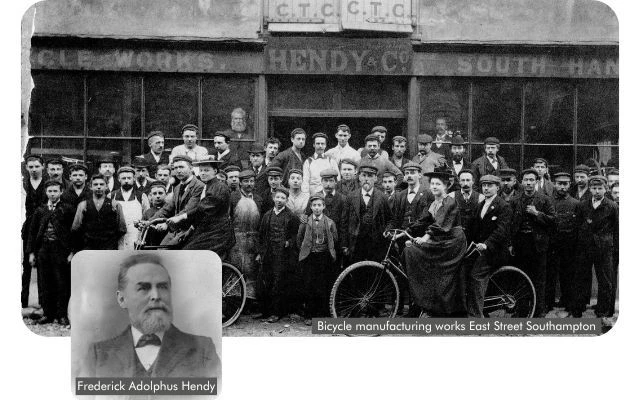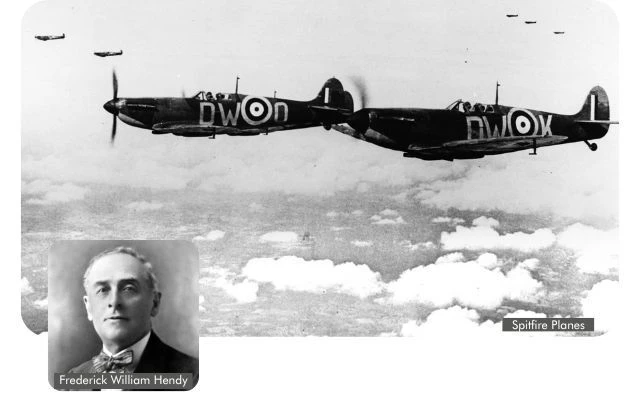Vans and trucks for sale
Electric & Hybrid
Vans and trucks for sale
Electric & Hybrid

Many famous car makers started in the bicycle business. Hendy, too, began by spotting the growing popularity of this revolutionary new human-powered form of transport. The story begins in 1859. It is the year Big Ben chimes for the first time and Charles Darwin publishes his Origin of the Species.
Frederick Adolphus Hendy, just 25, starts selling bicycle clothing from the family home in the ancient Hampshire village of Whitchurch. The same home is also used by his father, for his grocery and shoemaking trade. Young Hendy’s move is both visionary – within a few decades the bicycle would become the world’s most popular form of personal transport – and a significant gamble.
Back in the mid 19th century, the bicycle was still in its early gestation. In those days, it was typically propelled by the feet and known as the ‘velocipede’ (or fast foot). A growing number of people – invariably affluent – needed the appropriate outdoor clothing to ride the new machine.
In 1865, the young but growing Hendy operation relocated to larger retail premises in East Street, Southampton. That’s when it started to sell bicycles, as well as the clothing to ride them. On top of selling bicycles, Hendy would go on to make them, producing its own Falcon, Solent King and Solent Queen brands.
Hendy’s timing was perfect. The pedal-propelled bicycle would arrive in the 1860s and quickly became fashionable. Their pedals powered the front wheels, like a child’s trike. They became known as ‘bone shakers’ owing to their iron-banded wooden wheels.
It wasn’t until the 1880s that the Rover ‘Safety’ bicycle set the design template for today’s machine, transforming the popularity of cycling – and transforming Hendy’s cycling business. When fitted with Dunlop’s newly invented pneumatic tyre – first used on bicycles – practicality (and comfort) was further enhanced. The modern bicycle was born.
Hendy would go on to add small engines to their bicycles, foreseeing the next big transport innovation – the motorcycle.
Transport was changing fast, and Hendy would prove equally perceptive when it came to the next revolution. The ‘horseless carriage’ (or motor car) first spluttered noisily into life in the 1880s. Before the turn of the century, Hendy was agents for Benz, the world’s first car maker, and for French motoring pioneer Bollé. Frederick Adolphus Hendy bought his first Benz in 1898.
Hendy would also become agents for De Dion, Daimler and Morris cars, among others, and sold Connaught, Matchless and Douglas motorcycles, too. If it was a thriving form of personal transport, Hendy was part of it.
In 1910, the Hendy business received a huge boost. Conscious of the potential of the new Model T Ford, recently launched in America, the Hendy family was keen to become agents. Percy Hendy, youngest son of Frederick, met Henry Ford shortly after he arrived in Southampton, by ship from America, to announce his new factory in Trafford Park, Manchester. At Southampton docks, on November 7, 1910, the first Ford dealer agreement in Britain was signed.
Hendy had become the first Ford dealer in Britain. A year later, the first British-produced Model T rolled off the production line. It would soon become Europe’s biggest car plant. Ford vans, sold by Hendy, would also go on to dominate the market.
Business boomed and Hendy bought more premises in Southampton and expanded into Boscombe. It was beginning to build the South Coast footprint for which it is now renowned.
In 1923, Frederick Adolphus died, aged 89, leaving his eldest son Frederick William Hendy to take over as Chairman and Managing Director. Frederick stayed in charge until his death in 1939, when he was succeeded by his younger brother Percy.
But 1939 would be remembered for a far more sombre event, the outbreak of World War II. The company had survived previous crises, including World War I and the Great Depression. It now had to survive the deadliest event of all.
Heavy bombing in Southampton had damaged Hendy’s Pound Tree Road premises. In 1940, the Luftwaffe bombed the Supermarine Spitfire factory in Southampton. Subsequently, the Ministry of Aircraft Production requisitioned Hendy’s Vincent Walk (Southampton) and Chandler’s Ford premises to assist with production. They now had to stop selling and servicing cars and tractors, and build Spitfires instead.
Post war, the Ford business boomed as models such as the Consul, Anglia and Zephyr won over buyers. In 1956, Percy Hendy died and was succeeded as Chairman by his nephew Arthur Hendy. Meanwhile popular new Ford models of the 1960s such as the Cortina and Escort saw business continue to prosper, as Ford became the UK car market leader.
Hendy’s Ford business kept expanding, into Bournemouth, Portsmouth and Southsea. Hendy was diversifying, too. Hendy Industrial Engines – later Hendy Power – offered cutting-edge engine testing facilities. Iveco trucks were sold from 1976.
As the century unfolded, Hendy diversified further into vehicle leasing, rental, specialist vehicle manufacturing (including tow tractors for the Ministry of Defence) and motorsport, winning the 1991 and 1992 British National Rally Championships.
Acutely aware of the growing popularity (and promise) of the Japanese car makers, Hendy opened a Honda dealership in Exeter in 1996. A second Honda dealership opened in Barnstaple in 1997. After 60 years of Ford exclusivity, Hendy was diversifying into other car marques.
Under current Chief Executive Paul Hendy, the group now sells more than 20 different brands in 70 locations across the South Coast, from Devon to Kent. Paul took the reins in 2002 from his father Norman and his uncle Brian. He is the seventh Hendy to head up the family business, and the fifth generation of Hendy.
Under Paul, the Hendy Group has enjoyed unprecedented expansion. Since 2014, it has grown six-fold – through both acquisition and organic growth – and now turns over more than £1.2 billion a year. Yet it is still family run and still very much a South Coast business, true to its roots that go back 165 years.

.jpg.webp)


.jpg.webp)